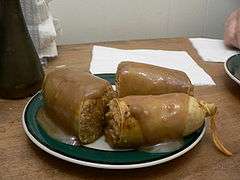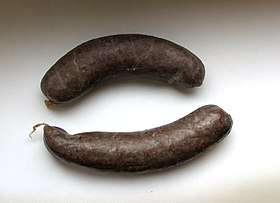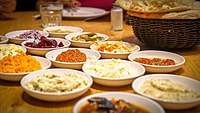Kishka (food)
Kishka or kishke (Belarusian кішка, kishka; Polish: kiszka / kaszanka; Romanian chişcă; Yiddish קישקע : kishke; Hebrew קישקע; Russian кишка; Ukrainian кишка; also Slovene: kašnica; Lithuanian vėdarai) refers to various types of sausage or stuffed intestine with a filling made from a combination of meat and meal, often a grain. The dish is popular across Eastern Europe as well as with immigrant communities from those areas. It is also eaten by Ashkenazi Jews who prepare their version according to kashrut dietary laws.

The name kishke is Slavic in origin, and literally means "gut" or "intestine."[1] It may be related to the Ancient Greek word κύστις : kystis, bladder as both words refer to a hollow viscus.
Description

One Eastern European kishka type is kaszanka, a blood sausage made with pig's blood and buckwheat or barley, with pig intestines used as a casing.[2] Similar to black pudding, it is traditionally served at breakfast.
Kishkas can also be made with an organ meat, such as liver and various grain stuffings. The cooked kishke can range in color from grey-white to brownish-orange, depending on how much paprika is used and the other ingredients. Greater Białystok Area kiszka is usually made in a way very similar to the Jewish kishke, but in the majority of cases, pig intestines are used, and ground potatoes are the main ingredient. There are also vegetarian kishka recipes.[3][4]
The sausages are popular in areas of the Midwestern United States, where many Poles emigrated. There are numerous mail order companies and delis that sell various kishkas. As blood is often used as an ingredient, kishkas are considered an acquired taste. Kosher kishka recipes omit animal blood and pork products.
Jewish cuisine
Kishke, also known as stuffed derma (from German Darm, "intestine"), is a Jewish dish traditionally made from flour or matzo meal, schmaltz and spices.[5][6][7] In modern cooking, synthetic casings often replace the beef intestine.[8] Kishke is a common addition to Ashkenazi-style cholent.[9]
Prepared kishke is sold in some kosher butcheries and delicatessen; in Israel it is available in the frozen-food section of most supermarkets. Non-traditional varieties include kishke stuffed with rice and kishke stuffed with diced chicken livers and ground gizzards.[7] There are also vegetarian kishke recipes.[10][11]
The stuffed sausage is usually placed on top of the assembled cholent and cooked overnight in the same pot. Alternatively it can be cooked in salted water with vegetable oil added or baked in a dish, and served separately with flour-thickened gravy made from the cooking liquids.[7][12]
"Who Stole the Kishka?"
"Who Stole the Kishka?" (originally spelled "Who Stole the Keeshka?") is a traditional polka tune, composed in the 1950s by Walter Solek and recorded and played by various bands. One popular version was familiar to American radio audiences from a 1963 recording by Grammy award-winning polka artist Frankie Yankovic.
Depending on the performer, the song can also include references to other Polish foods such as:
You can have my shinka
Take my sweet krusczyki
Take my plump pierogi
You can even have my serniczki
Take my long kielbasa
See also
- Haggis
- Chitterlings
- Pacha
References
- Frederic Gomes Cassidy, Joan Houston Hall (1985), “kishka” and “kishke” in Dictionary of American Regional English, p 228, Harvard University Press, ISBN 0-674-20519-7
- Polish Pork Primer by Dana Bowen Issue #105 Saveur
- Vegetarian Kishka recipe
- Vegetarian Kishka
- Kishke and stuffed derma in Jewish cookery in Random House Unabridged Dictionary (2006) and The American Heritage Dictionary of the English Language (4th ed., 2006).
- "Kishke, culture, and celebrity chefs", an interview on zeek.net, February 2007
- Ansky, Sherry, Hamin (Hebrew; English title Tscholent), Keter Books, Jerusalem, 2008.
- Kishke recipe
- Daniel Rogov's "Feasting on cholent"
- Vegetarian kishke recipe for Passover
- Vegetarian kishka, recipe from yedidya.org.il
- Claudia Roden, The Book of Jewish Food: An Odyssey from Samarkand to New York, Alfred Knopf, New York (1996), p. 129.
External links
| Look up kishka in Wiktionary, the free dictionary. |

